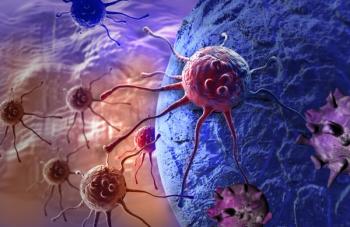
Preventing Exposure to Hazardous Drugs
Nurses can implement interventions in the workplace to prevent environmental contamination and personal exposure to hazardous drugs.
This session’s goal was to outline interventions that nurses can implement in the workplace to prevent environmental contamination and personal exposure to hazardous drugs. For a drug to be defined as hazardous, it must have one of the following properties:
• Carcinogenicity;
• Teratogenicity;
• Reproductive toxicity;
• Organ toxicity at low doses;
• Genotoxicity;
• Structure or toxicity similar to drugs classified as hazardous (NIOSH, 2004).
Martha Polovich, PhD, RN, AOCN
Martha Polovich, PhD, RN, AOCN, director of clinical practice, nursing research and education, Duke Oncology Network, Durham, North Carolina, discussed these topics in her presentation, “Oncology Nurses: Self Care With Chemotherapy,” at Scripps Cancer Center’s 32nd annual Oncology Nurses Symposium, held October 7–10, in San Diego.
Nurses’ vulnerability to the effects of antineoplastic agents is of concern as they may be exposed to low doses of many different types of drugs over a period of years. Potential routes of exposure include dermal absorption (ie, direct drug contact, contact with contaminated surfaces), injection (ie, sharps, breakages), ingestion (ie, via contaminated food, hand-to-mouth transfer), and inhalation (ie, aerosols, vapors). Examples of adverse outcomes from occupational exposure include acute symptoms (ie, nausea, dizziness, nasal sores), reproductive effects (ie, fetal abnormalities, miscarriage, infertility), genotoxicity (ie, mutations on chromosomes 5 and 7), and cancer (ie, increased overall risk, leukemia, lymphoma).
Dr. Polovich stressed the use of personal protective equipment (PPE). Specifically:
• Gloves: two pairs of powder-free, made either of latex, nitrile, or neoprene, tested with hazardous drugs;
• Gowns: disposable, single-use, with cuffs and back closure, tested with hazardous drugs.
Barriers to PPE use include discomfort (ie, heat), inconvenience, unavailability, and job interference. The more barriers that are present, the more likely the nurse is to not use proper PPE.
The following represents some key points that should be considered and translated into clinical practice:
• Gloves are always considered contaminated after chemotherapy handling;
• Double gloving is necessary for two reasons: 1) to prevent against permeation of some therapy; and 2) to prevent transfer of contamination from outer gloves to hands and other surfaces;
• Gloves should be worn when handling oral chemotherapy;
• Saving and reusing gowns may result in drug transfer to the environment and workers’ clothing.
To enhance adherence to PPE use, consider the following:
• Have staff trial various gloves and gowns, and solicit their feedback on the quality and comfort of products;
• Be sure PPE is stored in convenient locations, and an adequate supply is available.
• Have written policies and procedures that require and expect PPE use for all hazardous handling activities;
• Provide orientation and validate competency for safe handling;
• Implement the ONS/ASCO Chemotherapy Safety Standards.
In this current climate of safety within healthcare settings, nurse safety is equally paramount. Taking an inventory of one’s practice setting by benchmarking against national guidelines is a necessary step to ensure workplace safety for all involved.
Newsletter
Stay up to date on recent advances in the multidisciplinary approach to cancer.

























































































